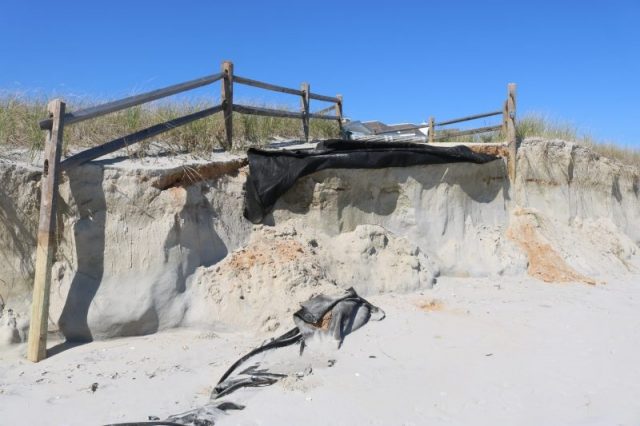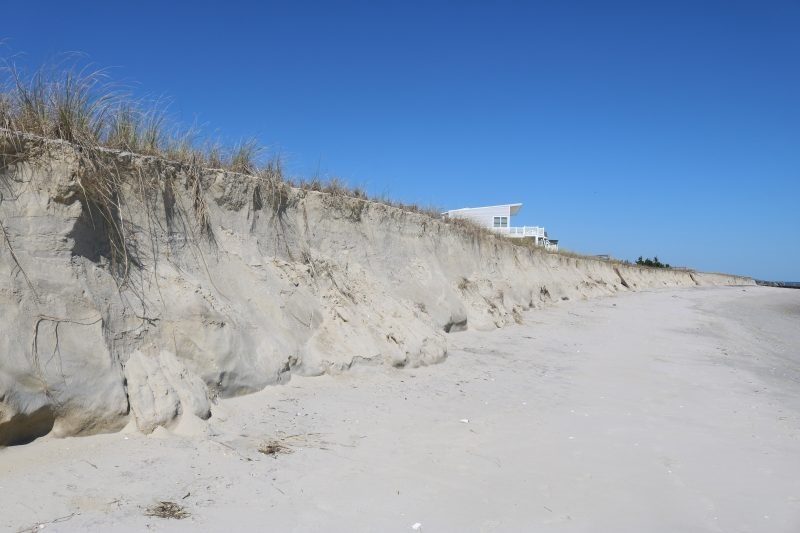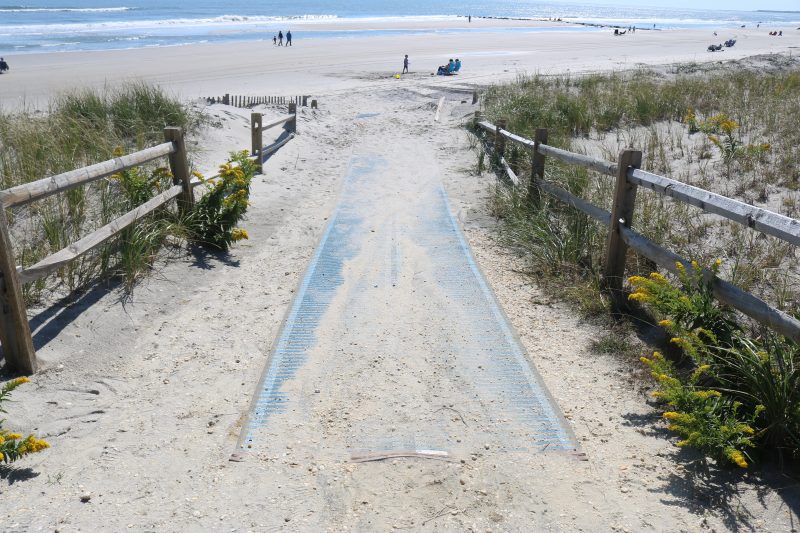
By DONALD WITTKOWSKI
Sea Isle City’s beaches and dunes suffered “major” damage in some areas during the stalled coastal storm that pounded the Jersey Shore in the first week of October, according to a newly released state report.
The New Jersey Department of Environmental Protection conducted a detailed survey and damage assessment of 81 beachfront sites in Atlantic, Cape May, Cumberland, Monmouth and Ocean counties in the aftermath of the storm.
Of all the sites that were surveyed, 63 had only minor beach or dune erosion. However, six sustained moderate erosion and 12 suffered major damage to the beaches and dunes. Sea Isle was one of the 12 communities having major damage, the report says.
Most of the significant damage in Sea Isle was concentrated on the beaches and dunes near John F. Kennedy Boulevard in the center of town and in the Townsends Inlet section of the island south of 84th Street.
In some spots, the waves washed up to the upper portions of Sea Isle’s beaches and dunes during high tide. The ocean actually penetrated into the dunes in some areas, according to the report.
The remnants of Hurricane Ian and a strong nor’easter that lingered along the coast for four days during the first week of October packed a one-two punch that caused significant erosion to Sea Isle’s beaches, pathways and dunes.

Perhaps most visually striking were steep mini-cliffs that were created when the raging ocean sheared away the face of a stretch of dunes between 84th and 92nd streets in Townsends Inlet. Some of the drop-offs were as high as 14 feet, the state report says.
Sections of Sea Isle’s beaches, particularly near JFK Boulevard, appeared to have been stripped of much of the top layer of powdery sand. However, the DEP report raised hope that the so-called “dry” beaches in Sea Isle and other towns where the sand was washed away may eventually be restored by natural means.
“It is often the (DEP’s) experience that much of the material eroded from the ‘dry’ beach area has not been lost, but rather redistributed within the beach profile system, such as creation or enlargement of offshore sand bars. Our expectation is that much of this material will return to the ‘dry’ beach in time following the storm; this time frame may vary based on several contributing factors such as storm frequency and duration,” according to the report.
Sea Isle officials led by Mayor Leonard Desiderio toured the beaches on Oct. 7 for a close-up look at the erosion. Desiderio said he was happy to see that the dune system did its job by protecting homes and businesses along the entire length of the island.
“Unfortunately, we did have some beach erosion; but overall our beaches are not nearly as bad as we initially feared,” he said in a statement. “There are, however, some areas where the dunes were damaged and the beach entrances were cut off, which resulted in some dunes having cliff-like faces on their eastern sides.”
Desiderio noted that the beaches in the city’s north end remain in good shape as well as those near the inlet that Sea Isle shares with Avalon in the south part of town.
“However, the beaches and dunes around JFK Boulevard and numerous stretches in the south end of town, particularly between 85th and 92nd streets, did lose a good amount of sand,” he said.

Sea Isle’s beaches remain open, but there are some pathways that have been blocked off because of the steep drop-offs in the dunes.
The city’s Public Works Department has been using earthmovers to level off some of the damaged beach pathways so that they could be reopened to the public.
Desiderio noted that Sea Isle has already been in contact with the DEP and the U.S. Army Corps of Engineers to address the beach and dune erosion.
“(Sea Isle) will continue to work with them to ensure that our shoreline remains strong,” he said in the statement.
Sea Isle is expected to benefit from good timing for its next beach replenishment project supervised by the Army Corps of Engineers. In 2023, Sea Isle, Strathmere and the south end of Ocean City will be part of an estimated $30 million project to replenish the beaches with new sand. The contract for that project still must be awarded, so it is not yet known when the project will start and be completed.
“All areas that need replenishment will be included in the project; and, at this point, we expect the project to include at least the downtown beaches fronting the Promenade and the beaches in Townsends Inlet south of 80th Street. That being said, definite locations for beach replenishment will not be established until the project is awarded,” city spokeswoman Katherine Custer said Monday in an email.
Regardless of when the replenishment project takes place, beach closures will be limited to only the area where the work is taking place. The same procedure was followed in previous beachfill projects, Custer noted.
“We don’t shut down our entire shoreline at one time – just the areas where work is being performed, thus to limit the impact on the public,” she said.








